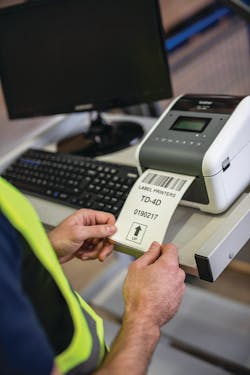Barcode labeling innovations: What processors need to know to drive efficiencies
Printing barcodes and human-readable text — and regularly scanning those labels — makes everything more visible within a company in real time. It helps identify bottlenecks and reduce errors in the manufacturing process. It holds people accountable for their work. It also improves communications with suppliers, logistics providers and customers.
Compared with other technology investments, barcoding is relatively inexpensive, easy to implement and offers a quick return on investment. For this reason, it is often considered the low-hanging fruit of operational improvement.
What follows are ideas on how process manufacturers use barcoding today, and how to choose the right label printers for your business.
Getting started
The first step in implementing barcoding is to determine the areas that will create the most value for your organization. Process manufacturers typically use barcode labeling to track:
- Ingredients, including supplier lot numbers, expiration dates and inventory levels
- Work in process, including container IDs, vat numbers and work instructions
- Finished goods, including production dates and times, rack and storage locations
- Quality testing, including sample IDs, specimen labeling and inspection data
- The same efficiencies that make barcode labeling critical to the manufacturing process also add value in:
- Compliance, printing regulatory, safety and customer-specific labeling requirements
- Facility labeling, printing safety warnings and asset tags and for marking control panels, switches and cables
- Warehouse, printing labels for racks, shelves and bins to ensure accurate put-away locations
- Loading dock, printing inbound receiving, put-away and inspection labels, and outbound shipping labels
Selecting the right printer for the right job
Once you have identified the primary areas where labeling can help, you’ll need to identify the different label sizes and their required lifespan — or how long each label needs to remain 100% scannable. Specimen labels in the quality department need to be smaller and last longer than the labels for shipping cartons, for example.
This information is essential for determining which of the two types of thermal printing technology is best for each application.
Direct thermal printers use heat to burn text and barcodes onto thermal-sensitive paper. This printing method is widely used for generating receipts and shipping labels that are used right away. The images are more sensitive to light, heat and abrasion, making them best suited for short-term or indoor applications. However, recent innovations have paved the way for high-resolution direct thermal labels that can last for extended periods before fading.
Thermal transfer printers are the preferred method for labels that need to withstand the test of time. Thermal transfer printers use ribbons and heat to melt the ink, generating high-resolution images, barcodes and text that become part of the label. The output is more durable and permanent, even when exposed to chemicals, high heat or the sunlight. Thermal transfer printers work with standard and specialty media, and are available in a wide variety of paper and synthetic materials including mylar, polyester and polypropylene.
Next, estimate how many labels of each type you’ll need to print on a daily, weekly or monthly basis. For departments with a high printing volume, rest assured that today’s advanced direct thermal and thermal transfer printers are fast, and some print up to eight inches of high-resolution labels per second. That’s equivalent to 40 feet of labels every minute.
Performance considerations
The printers you select should include software for easily designing a wide range of barcode and text labels. They should also seamlessly integrate with and print directly from your ERP system or other business software, using laptops or PCs as well as tablets and smartphones.
Be sure you identify the printer’s standard wireless and wired connectivity options, such as Ethernet LAN, USB, Bluetooth or Wi-Fi. Lightweight printers with rechargeable batteries are space-savers that can be moved around as needed. These compact desktop models fit easily on a desk or work bench. Compare these with ruggedized mobile printers that are clipped to a belt or worn with a strap by always-mobile workers. It’s not unusual for companies to select a combination of printer models based on their applications.
Test the printer models for usability. All should be easy to set up with intuitive controls. Also, make sure it is easy to change ribbons or load new media. This is critical if you have high turnover or use temporary employees, so printer downtime doesn’t bring productivity to a halt.
Once you’ve selected the best printers for your needs, you’ll want them to be with you for the long haul. A two-year warranty will give you the satisfaction that these printers are built to last and backed by the manufacturer to deliver dependable performance.
Budget-friendly advice
The number of printers and scanners you need will vary by department, volume and printing method. High-volume printing locations will require dedicated printers. Infrequent labeling applications may be able to share a compact desktop or mobile printer.
Now it’s time to make sure your budget can handle the technology that best matches your applications.
Fortunately, advances in thermal printing have narrowed the price gap between direct thermal and thermal transfer methods. Some next-generation printers now offer the best of both worlds: printers that give you the option of printing with either method for the ultimate in versatility and cost-effectiveness.
In addition, more solutions providers have options coming online that can shift acquisition costs from a capital equipment expense (CapEx) to an operating cost (OpEx). Hardware as a Service (HaaS) and other subscription or managed print service plans may be the solution to help your facility quickly start reaping the benefits of barcoding throughout your now-more-efficient operation.
Ravi Panjwani is the vice president of marketing and product management at Brother Mobile Solutions.

